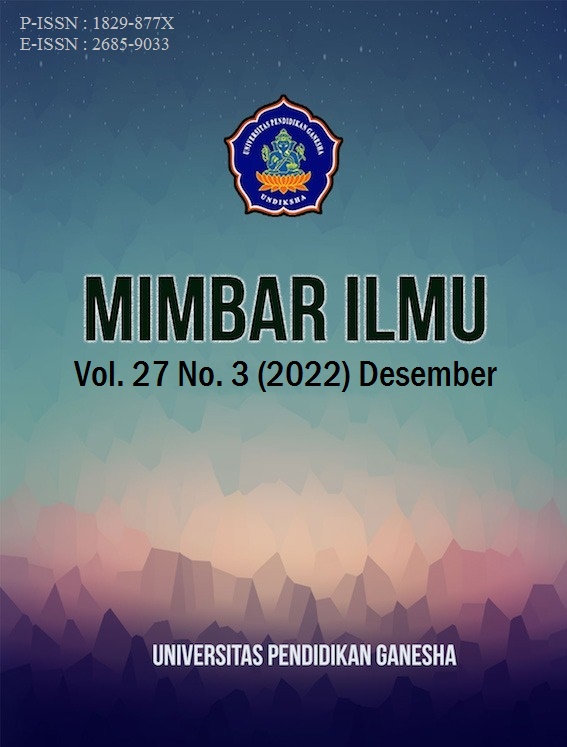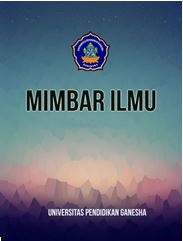Tri Hita Karana Education in “Monkey and Streaked Weaver” Story: Implementation by the Ubud Community
DOI:
https://doi.org/10.23887/mi.v27i3.57630Keywords:
Tri Hita Karana, Education, Story, Ubud CommunityAbstract
Seiring dengan perkembangan teknologi, tradisi lisan mendongeng mulai ditinggalkan. Tradisi lisan bercerita kepada masyarakat sangat penting dalam upaya menyampaikan konsep yang baik berdasarkan kearifan lokal. Penelitian ini bertujuan untuk menganalisis pendidikan Tri Hita Karana yang terkandung dalam cerita ‘Monyet dan Penenun Lurik’ dan implementasinya dalam kehidupan masyarakat Ubud. Data dikumpulkan dari studi dokumentasi dan wawancara dengan 62 orang masyarakat Ubud. Peneliti mendokumentasikan sinopsis cerita dan menganalisis implementasi esensi cerita dalam kehidupan sehari-hari masyarakat Ubud. Hasil penelitian menunjukkan bahwa pendidikan Tri Hita Karana, muncul dalam cerita. Pelaksanaannya berdasarkan cerita tersebut juga dilaksanakan oleh masyarakat Ubud, seperti upacara yang dilakukan ditujukan kepada Tuhan (Parahyangan). Hubungan yang harmonis antara masyarakat Ubud dengan wisatawan yang berkunjung ke Ubud (Pawongan). Masyarakat Ubud melestarikan tumbuhan dan hewan (Palemahan). Dengan diterapkannya pendidikan Tri Hita Karana, masyarakat Ubud meyakini akan berdampak signifikan terhadap terwujudnya kesejahteraan masyarakat.
References
Abdullah, A. (2014). Falsafah Kolom di Era Postmodernisme. Yogyakarta: Pustaka Pelajar.
Adhitama, S. (2020). Konsep Tri Hita Karana Dalam Ajaran Kepercayaan Budi Daya. Dharmasmrti: Jurnal Ilmu Agama Dan Kebudayaan, 20(2), 29–45. https://doi.org/10.32795/ds.v20i2.1020.
Arnyana, I. B. P., & Utami, I. A. M. I. (2022). The Implementation of Tri Hita Karana Culture-Based Character Education at Pasraman Budi Pekerti, Kemenuh Village, Bali. Proceedings of the 4th International Conference on Innovative Research Across Disciplines (ICIRAD 2021), 613, 279–285. https://doi.org/10.2991/assehr.k.211222.045.
Astawa, I. G., Budiarsa, M., & Simpen, I. W. (2019). The Representation of The Tri Hita Karana Ecosophy in The Awig-awig (Customary Law) Text of Tenganan Pegringsingan Village: Critical Ecolinguistics Perspective. Journal of Language Teaching and Research, 10(2), 396. https://doi.org/10.17507/jltr.1002.23.
Chong, S. L. (2017). Many Languages, Whither Literacy? Understanding the Ontology of Reading in Linguistically-diverse Contexts. 3L: Language, Linguistics, Literature, 23(2), 1–13. https://doi.org/10.17576/3L-2017-2302-01.
Dewi, E. (2019). Potret Pendidikan di Era Globalisasi: Teknosentrisme dan Proses Dehumanisasi. Sukma: Jurnal Pendidikan, 3(1), 93–116. https://doi.org/10.32533/03105.2019.
Dewi, I. G. A. A. O. (2018). Culture of tri hita karana on ease of use perception and use of accounting information system. International Journal of Social Sciences and Humanities (IJSSH), 2(2), 77–86. https://doi.org/10.29332/ijssh.v2n2.131.
Engelenhoven, G. (2021). From Indigenous customary law to diasporic cultural heritage: reappropriations of adat throughout the history of moluccan postcolonial migration. International Journal for the Semiotics of Law, 34(3), 695–721. https://doi.org/10.1007/s11196-020-09781-y.
Hendriani, D. (2020). Introduction to History in Early Childhood with Storytelling Method. Candra Sangkala, 2(1). https://doi.org/10.23887/jcs.v2i1.28802.
Jamaluddin, A. Bin, Zubaidah, S., Mahanal, S., & Gofur, A. (2022). Exploration of the Indonesian Makassar-Buginese Siri’ educational values: The foundation of character education. International Journal of Evaluation and Research in Education, 11(1), 10–19. https://doi.org/10.11591/ijere.v11i1.21670.
Laila, A., Asri Budiningsih, C., & Syamsi, K. (2021). Textbooks based on local wisdom to improve reading and writing skills of elementary school students. International Journal of Evaluation and Research in Education, 10(3), 886–892. https://doi.org/10.11591/ijere.v10i3.21683.
Lilik, L., & Mertayasa, I. K. (2019). Esensi Tri Hita Karana Perspektif Pendidikan Agama Hindu. Bawi Ayah: Jurnal Pendidikan Agama Dan Budaya Hindu, 10(2), 60–80. https://doi.org/10.33363/ba.v10i2.373.
Lisenbee, P. S., & Ford, C. M. (2018). Engaging Students in Traditional and Digital Storytelling to Make Connections Between Pedagogy and Children’s Experiences. Early Childhood Education Journal, 46(1), 129–139. https://doi.org/10.1007/s10643-017-0846-x.
Malini, N. N. S., Laksminy, L. P., & Sulibra, N. K. N. (2017). The System of Balinese Language Inheritance at International Tourism Destinations in Bali. Udayana Journal of Social Sciences and Humanities, 1(1), 63. https://doi.org/10.24843/ujossh.2017.v01.i01.p10.
Mandra, I. W., & Dhammananda, D. (2020). Implementation Of Tri Hita Karana Teaching To Form Students Characters Quality. Jurnal Penjaminan Mutu, 6(1), 60. https://doi.org/10.25078/jpm.v6i1.1300.
Martono, M. (2019). Improving Students Character Using Fairy Tales. JETL (Journal Of Education, Teaching and Learning), 4(1), 180. https://doi.org/10.26737/jetl.v4i1.993.
Moradi, H., & Chen, H. (2019). Digital storytelling in language education. Behavioral Sciences, 9(12), 1–9. https://doi.org/10.3390/bs9120147.
Moustafa, B. S. M. (2022). A comparative corpus stylistic analysis of thematization and characterization in Gordimer’s My Son’s Story and Coetzee’s Disgrace. Open Linguistics, 8(1), 46–64. https://doi.org/10.1515/opli-2020-0183.
Nadhiroh, U. (2021). Peranan Pembelajaran Bahasa Jawa Dalam Melestarikan Budaya Jawa. JISABDA: Jurnal Ilmiah Sastra Dan Bahasa Daerah, Serta Pengajarannya, 3(1), 1–10. https://doi.org/10.26877/jisabda.v3i1.9223.
Nekaris, K. A. I., McCabe, S., Spaan, D., Ali, M. I., & Nijman, V. (2018). A novel application of cultural consensus models to evaluate conservation education programs. Conservation Biology, 32(2), 466–476. https://doi.org/10.1111/cobi.13023.
Nengsih, S. W. (2020). Kearifan Lokal Dalam Legenda Keagamaan Masyarakat Banjar. Jurnal Bahasa, Sastra Dan Pembelajarannya, 10(1), 41. https://doi.org/10.20527/jbsp.v10i1.8395.
Nuraini, N., & Abidin, Z. (2020). Kesulitan guru dalam mengimplementasikan pembelajaran tematik terintegratif di sekolah dasar. Premiere Educandum : Jurnal Pendidikan Dasar Dan Pembelajaran, 10(1), 49. https://doi.org/10.25273/pe.v10i1.5987.
Nurkancana, W. (2011). Pokok-Pokok Ajaran Agama Hindu. Denpasar: Pustaka Manik Geni.
Parina, J. C. M., & De Leon, K. D. (2014). A Stylistic Analysis of the Use of Modality: To identify the Point of View in a Short Story. 3L: Language, Linguistics, Literature, 20(2), 91–101. https://doi.org/10.17576/3L-2014-2002-08.
Puspitadewi, I. D. A., Windia, W., & Astiti, N. W. S. (2015). Analisis Pengaruh Penerapan Tri Hita Karana terhadap Tingkat Kepuasan Wisatawan di Kawasan Agrowisata Ceking, Kecamatan Tegallalang, Kabupaten Gianyar. Jurnal Manajemen Agribisnis, 3(1), 43–52. https://ojs.unud.ac.id/index.php/destinasipar/article/download/67998/37617.
Putra, I. B. R., Jelantik, I. B., & Argawa, I. N. (2013). Swastikarana: Pedoman Ajaran Hindu Dharma. Denpasar: Mabhakti.
Rezaei, S., & Naghibian, M. (2018). Developing Intercultural Communicative Competence through Short Stories: A Qualitative Inquiry. Iranian Journal of Language Teaching Research, 6(2), 77–96. https://doi.org/10.30466/ ijltr.2018.120561.
Roth, D., & Sedana, G. (2015). Reframing Tri Hita Karana: From ‘Balinese Culture’to Politics. The Asia Pacific Journal of Anthropology, 16(2), 157–175. https://doi.org/10.1080/14442213.2014.994674.
Sablez, L., & Frances, R. (2020). Analysis of the Effect of Storytelling on Early Childhood Speaking Ability. Tambusai Journal of Education, 4(3), 3550–3557. https://jptam.org/index.php/jptam/article/view/892.
Sarjana, I. P., Gelgel, I. P., & Utama, I. W. B. (2020). The Dynamics of Tri Hita Karana Implementation in The Balinese Hindu Residence in South Denpasar. International Journal of Interreligious and Intercultural Studies, 3(2), 58–68. https://doi.org/10.32795/ijiis.vol3.iss2.2020.1091.
Suandi, I. N., & Mudana, I. W. (2020). Upaya Pelestarian Bahasa dan Budaya Bali Melalui Pengembangan Kamus Seni Tari Bali. Jurnal Komunikasi Hukum (JKH), 6(1), 335–353. https://doi.org/10.23887/jkh.v6i1.24659.
Suastra, I. W., & Yasmini, L. P. B. (2013). Model Pembelajaran Fisika untuk Mengembangkan Kreativitas Berpikir dan Karakter Bangsa Berbasis Kearifan Lokal Bali. JPI (Jurnal Pendidikan Indonesia), 2(2), 221–235. https://doi.org/10.23887/jpi-undiksha.v2i2.2166.
Sudira, P. (2011). Praksis Ideologi Tri Hita Karana dalam Struktur dan Kultur Pendidikan Karakter Kejuruan pada SMK di Bali. Jurnal Pendidikan Karakter, 1(1), 1–17. https://doi.org/10.21831/jpk.v1i1.1313.
Sukadi. (2007). Studi Etnografi Pendidikan pada SMA Negeri 1 Ubud Bali. Cakrawala Pendidikan, 1(1), 1–18. https://doi.org/10.21831/cp.v1i1.8554.
Sukarma, I. W. (2016). Tri Hita Karana theoretical basic of moral Hindu. International Journal of Linguistics, Literature and Culture, 2(3), 102–116. https://core.ac.uk/download/pdf/230594757.pdf.
Temaja, I. G. B. W. B. (2021). Pentingnya makna dan nilai budaya konsep kaja kangin (utara timur) di Bali pada anak. Widya Kumara Jurnal Pendidikan Anak Usia Dini, 2(2), 189–198. https://doi.org/10.55115/widyakumara.v2i2.1566.
Tohri, A., Rasyad, A., Sururuddin, M., & Istiqlal, L. M. (2022). The urgency of Sasak local wisdom-based character education for elementary school in East Lombok, Indonesia. International Journal of Evaluation and Research in Education (IJERE), 11(1), 333. https://doi.org/10.11591/ijere.v11i1.21869.
Wardhani, N. K. S. K., Karmini, N. W., & Wibawa, I. P. S. (2020). Tri Hita Karana-Oriented Education as an Effort to Integrate Environmental Education in Bali High Schools. Talent Development & Excellence, 12(1), 3975–3983. http://sim.ihdn.ac.id/app-assets/repo/repo-dosen-112011123251-83.pdf.
Yefimenko, I. V., Yakymchuk, O. M., Kravtsova, N. Y., Sotska, H. I., & Korol, A. M. (2021). Art education development in the context of global changes. Linguistics and Culture Review, 5(S2). https://doi.org/10.21744/lingcure.v5ns2.1386.
Yuliandari, N. K., & Sunariani, N. N. (2020). Pendekatan Tri Hita Karana Dalam Meningkatkan Motivasi Berwirausaha Mahasiswa. Jurnal Manajemen Bisnis, 17(1), 118–132. https://doi.org/10.38043/jmb.v17i1.2346.
Downloads
Published
How to Cite
Issue
Section
License
Copyright (c) 2023 Ni Putu Parmini, I Gede Bagus Wisnu Bayu Temaja, Ida Bagus Rai Putra, Nyoman Alit Sudiarthi, I Wayan Mawa

This work is licensed under a Creative Commons Attribution-ShareAlike 4.0 International License.
This work is licensed under a Creative Commons Attribution-ShareAlike 4.0 International License.
Authors who publish with this journal agree to the following terms:
- Authors retain copyright and grant the journal right of first publication with the work simultaneously licensed under a Creative Commons Attribution License that allows others to share the work with an acknowledgment of the work's authorship and initial publication in this journal.
- Authors are able to enter into separate, additional contractual arrangements for the non-exclusive distribution of the journal's published version of the work (e.g., post it to an institutional repository or publish it in a book), with an acknowledgment of its initial publication in this journal.
- Authors are permitted and encouraged to post their work online (e.g., in institutional repositories or on their website) prior to and during the submission process, as it can lead to productive exchanges, as well as earlier and greater citation of published work.








